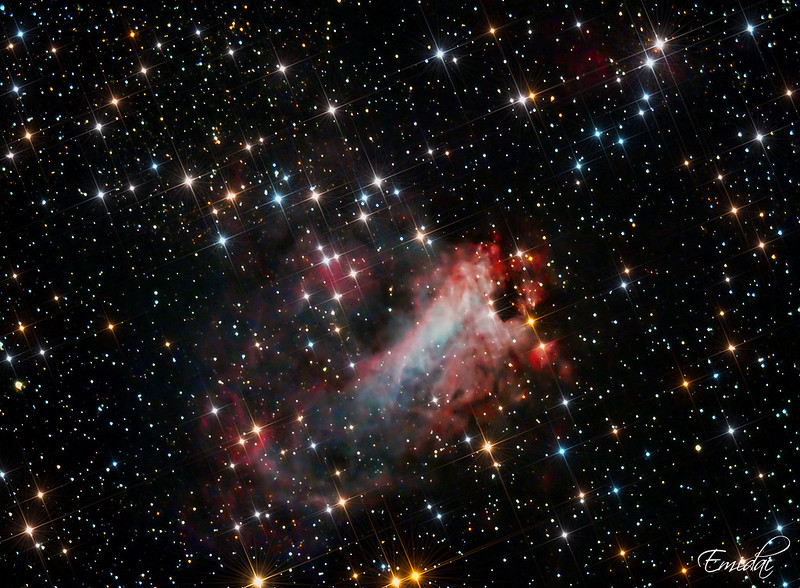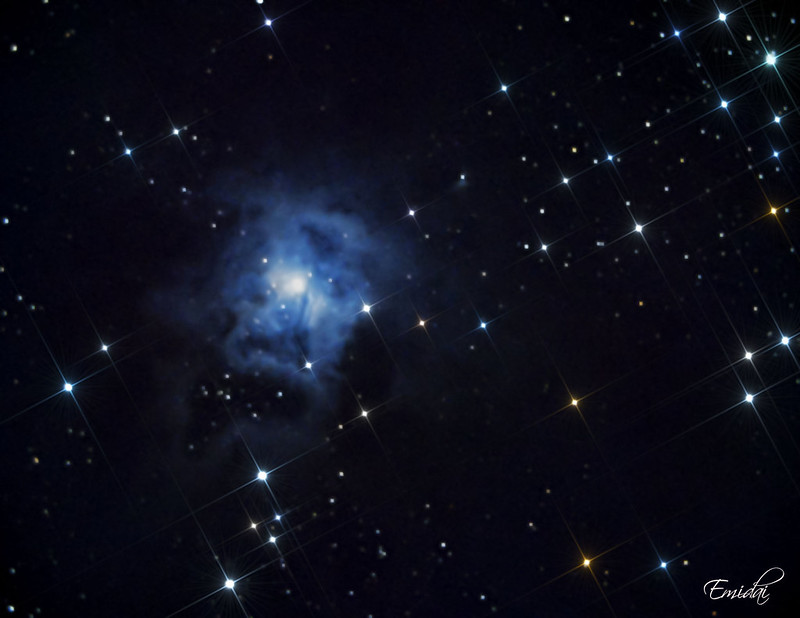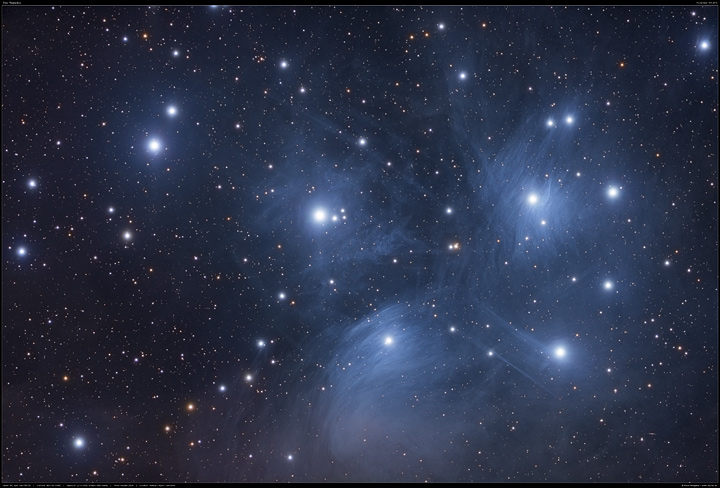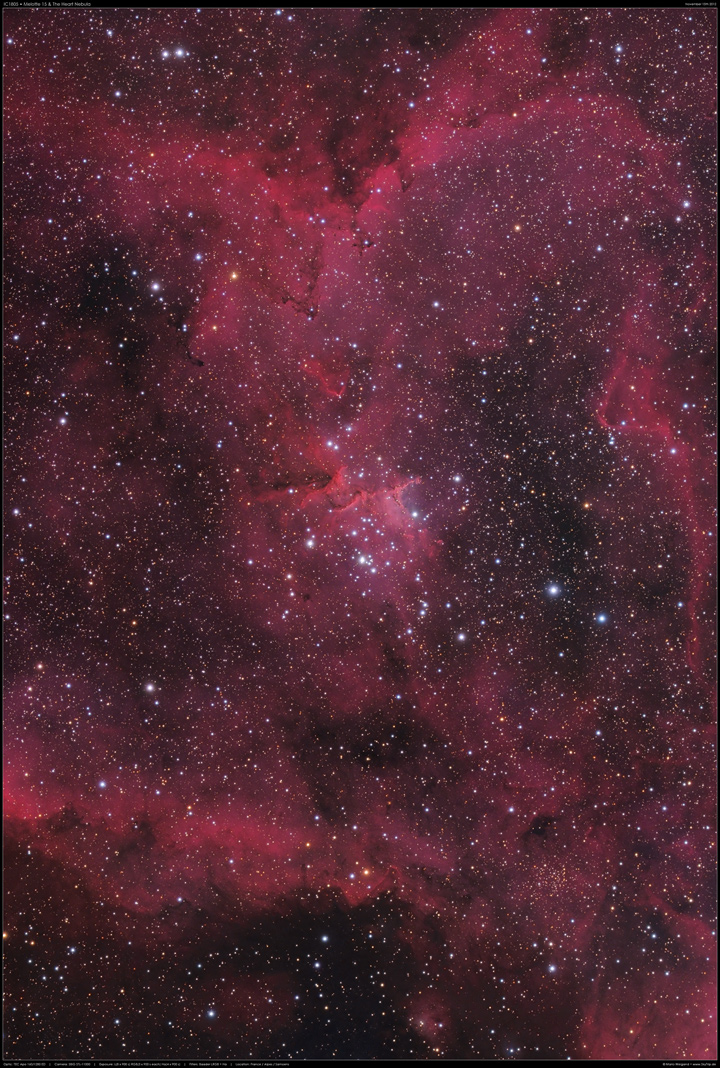Recent Submissions: 2012 November
-
ftherrmann
- Science Officer
- Posts: 141
- Joined: Sun Jan 30, 2011 2:56 am
Re: Recent Submissions: 2012 November
Mary Ann says thank you.IanP wrote:This is an amazing picture ..Editor57 wrote:Following the lead of the solar eclipse quilt from a couple of weeks ago, I have talked my wife into posting her quilt.
Horsehead in Orion By Mary Ann Andrews
La Canada, Ca
Would you share higher resolution copy? (Link or PM)
Thnx,
IanP
Western Australia
Her discription of the project :
"The small, about 2 x 4 light years, dust cloud resembling a horses head in the constellation Orion was created in threads and set off by polyester party dress fabrics portraying the glowing star formation radiation behind it. "
Larger Image here http://farm9.staticflickr.com/8347/8205 ... 5024_h.jpg
Last edited by bystander on Wed Nov 21, 2012 7:13 pm, edited 1 time in total.
Reason: please, no hot links to images > 400kb
Reason: please, no hot links to images > 400kb
- mexhunter
- Science Officer
- Posts: 467
- Joined: Tue Apr 27, 2010 1:41 pm
- AKA: César Cantú
- Location: Monterrey, Mexico.
- Contact:
Re: Recent Submissions: 2012 November
As I was unable to edit the previous post I write this to the same event.
Copyright: César Cantú
Polaris in downtown.
Also:
http://www.astrophoto.com.mx/picture.ph ... ategory/15
http://www.astrophoto.com.mx/upload/201 ... 261be9.jpg
Copyright: César Cantú
Polaris in downtown.
Also:
http://www.astrophoto.com.mx/picture.ph ... ategory/15
http://www.astrophoto.com.mx/upload/201 ... 261be9.jpg
I come to learn and to have fun.
Re: Recent Submissions: 2012 November
Star of wonder, star of light ..
copyright: robert Malinowski
http://www.flickr.com/photos/66085839@N ... hotostream
copyright: robert Malinowski
http://www.flickr.com/photos/66085839@N ... hotostream
From high on Haleakala Crater, Maui,
Jupiter rises on a moon lite night.
-
Emil Ivanov
- Science Officer
- Posts: 122
- Joined: Fri Jan 07, 2011 1:49 pm
- Location: Vienna, Austria
- Contact:
Re: Recent Submissions: 2012 November
M 41: open cluster in Canis Major
http://www.emilivanov.com/CCD%20Images/M41_crop.htm
Copyright: Emil Ivanov Details on webpage, larger image available here, wide field here.
http://www.emilivanov.com/CCD%20Images/M41_crop.htm
Copyright: Emil Ivanov Details on webpage, larger image available here, wide field here.
-
Emil Ivanov
- Science Officer
- Posts: 122
- Joined: Fri Jan 07, 2011 1:49 pm
- Location: Vienna, Austria
- Contact:
Re: Recent Submissions: 2012 November
IC 348 (Flying Ghost Nebula)
http://www.emilivanov.com/CCD%20Images/VdB19.htm
Copyright: Emil Ivanov Details on the webpage, larger image here
http://www.emilivanov.com/CCD%20Images/VdB19.htm
Copyright: Emil Ivanov Details on the webpage, larger image here
-
Harel_Boren
- Ensign
- Posts: 10
- Joined: Sat Nov 03, 2012 1:00 pm
NGC 6357: Cathedral amidst raging waves of fire
[attachment=0]NGC6357_Boren.jpg[/attachment]
http://m3.i.pbase.com/o4/27/876727/1/14 ... 20FLAT.jpg
This image is 1876x1247 pixels
Massive stars lie within NGC 6357, the central part of which is shown in the very middle of this image. That central region spans about 10 light years and the whole expansive complex lies about 8,000 light years away in the tail of the constellation Scorpius.
In fact, positioned just below center in this view of NGC 6357, star cluster Pismis 24 includes some of the most massive stars known in the galaxy, stars with over 100 times the mass of the Sun. The nebula's bright central region also contains dusty pillars of molecular gas, likely hiding massive protostars from the prying eyes of optical instruments. The intricate patterns are caused by complex interactions between interstellar winds, radiation pressures, magnetic fields, and gravity. The overall glow of the nebula results from the emission of light from ionized hydrogen gas (ref. http://apod.nasa.gov/apod/ap081009.html; http://apod.nasa.gov/apod/ap101121.html).
The unusual name of “War and Peace” was given to this nebula not because of the famous novel by Tolstoy, but was given to this object by scientists working on the Midcourse Space Experiment (see: http://en.wikipedia.org/wiki/Midcourse_Space_Experiment). They noted that the bright, western part of the nebula resembled a dove, while the eastern part looked like a skull in their infrared images. Unfortunately this effect cannot be seen in the visible-light image presented here. The object is also occasionally nicknamed the Lobster Nebula (ref. http://asterisk.apod.com/viewtopic.php?f=29&t=28928).
NGC 6357 was first recorded visually by John Herschel from South Africa in 1837. He only recorded the brightest central parts and the full scale of this huge nebula was only seen in photographs much later.
I've taken the name as a variation on the NASA APOD of Nov. 18th http://apod.nasa.gov/apod/ap121118.html)
It's actually a re-do and re-frame of an image I posted here some two months ago http://www.pbase.com/boren/image/146391038), shot from the Kalahari desert, Namibia, this August. While the former was a zoomed-out wide field, this one takes a close look at the raging Ha waves circling the Cathedral to Massive Stars ...
http://m3.i.pbase.com/o4/27/876727/1/14 ... 20FLAT.jpg
This image is 1876x1247 pixels
Massive stars lie within NGC 6357, the central part of which is shown in the very middle of this image. That central region spans about 10 light years and the whole expansive complex lies about 8,000 light years away in the tail of the constellation Scorpius.
In fact, positioned just below center in this view of NGC 6357, star cluster Pismis 24 includes some of the most massive stars known in the galaxy, stars with over 100 times the mass of the Sun. The nebula's bright central region also contains dusty pillars of molecular gas, likely hiding massive protostars from the prying eyes of optical instruments. The intricate patterns are caused by complex interactions between interstellar winds, radiation pressures, magnetic fields, and gravity. The overall glow of the nebula results from the emission of light from ionized hydrogen gas (ref. http://apod.nasa.gov/apod/ap081009.html; http://apod.nasa.gov/apod/ap101121.html).
The unusual name of “War and Peace” was given to this nebula not because of the famous novel by Tolstoy, but was given to this object by scientists working on the Midcourse Space Experiment (see: http://en.wikipedia.org/wiki/Midcourse_Space_Experiment). They noted that the bright, western part of the nebula resembled a dove, while the eastern part looked like a skull in their infrared images. Unfortunately this effect cannot be seen in the visible-light image presented here. The object is also occasionally nicknamed the Lobster Nebula (ref. http://asterisk.apod.com/viewtopic.php?f=29&t=28928).
NGC 6357 was first recorded visually by John Herschel from South Africa in 1837. He only recorded the brightest central parts and the full scale of this huge nebula was only seen in photographs much later.
I've taken the name as a variation on the NASA APOD of Nov. 18th http://apod.nasa.gov/apod/ap121118.html)
It's actually a re-do and re-frame of an image I posted here some two months ago http://www.pbase.com/boren/image/146391038), shot from the Kalahari desert, Namibia, this August. While the former was a zoomed-out wide field, this one takes a close look at the raging Ha waves circling the Cathedral to Massive Stars ...
Last edited by owlice on Thu Nov 22, 2012 11:08 pm, edited 1 time in total.
Reason: Attached smaller image for faster downloading; left link to larger image. Thanks for sharing!
Reason: Attached smaller image for faster downloading; left link to larger image. Thanks for sharing!
-
Harel_Boren
- Ensign
- Posts: 10
- Joined: Sat Nov 03, 2012 1:00 pm
AE Aurigae and IC405 - The Flaming Star Nebula
[attachment=0]FlamingStar_Boren.jpg[/attachment]
http://ic2.pbase.com/o4/27/876727/1/147 ... pixels.jpg
This image is: 1450x1079 pixels / 4.23"/Pixel
Location RA 05h 15m 52s, Dec +34° 31' 43" / Position Angle +270°43'
The Flaming Star nebula got its name from the appearance of the red ionized hydrogen and blue reflecting dust surrounding AE Aurigae - the brightest star in this image.
Just as As Mu Columbae speeds to the south away from Orion's Trapezium, from where it was hurled (rather from near where, since the Trapezium was not yet born), AE Aurigae zips away to the north - the two separating at some 200 km/sec.
The idea is that around two million years ago two massive binary stars collided close to where the M42 Trapezium now finds itself, in the middle of Orion's Sword. Two stars were exchanged to make the odd eccentric double Iota Orionis, while the other two were ejected to create the classic "runaway stars" mentioned, one of which is AE Aurigae.
AE Aurigae is a 5.96 mag. star, while the two-letter name implies variability (between magnitudes 5.4 and 6.1). The apparent faintness is a product of great distance (near 1450 light years, just a bit farther than Mu Col), and a significant amount of absorption by interstellar dust, which if it were not there would make AE Aur 0.8 magnitudes brighter, boosting it to mid-fifth.
Not surprisingly, Mu Col and AE Aur are similar, both class O (O9.5) hydrogen-fusing dwarfs, AE's temperature measured at 36,500 Kelvin and between 26,000 and 33,000 times the luminosity of the Sun, and at least 17 times solar masses, with a radius about 5 times that of the Sun.
Like the Pleiades in Taurus, AE is now passing through an unrelated interstellar cloud of gas and dust that it is illuminating.
Hot stars, with their simple spectra, make ideal backgrounds for the study of the spectra of intervening interstellar gases (which are superimposed on the stellar spectra), and AE is no exception. Indeed its very high speed across the line of sight of 90 km/s relative to the Sun allows the fine structure of the interstellar medium to be probed as the star passes in back of the wispy gasses, causing the interstellar spectrum to vary. There is really nothing all that unusual in such stars; some 15 % of O and B stars are runaways, some caused by binary interchange, others - like Zeta Ophiuchi - caused by one of the stars of a binary exploding off-center and ejecting the other.
AE's fate is to explode as well, but as a single star which will someday be no more but for a lonely neutron star left behind.
Most of this text is taken from Jim Kaler's http://stars.astro.illinois.edu/sow/aeaur.html
http://ic2.pbase.com/o4/27/876727/1/147 ... pixels.jpg
This image is: 1450x1079 pixels / 4.23"/Pixel
Location RA 05h 15m 52s, Dec +34° 31' 43" / Position Angle +270°43'
The Flaming Star nebula got its name from the appearance of the red ionized hydrogen and blue reflecting dust surrounding AE Aurigae - the brightest star in this image.
Just as As Mu Columbae speeds to the south away from Orion's Trapezium, from where it was hurled (rather from near where, since the Trapezium was not yet born), AE Aurigae zips away to the north - the two separating at some 200 km/sec.
The idea is that around two million years ago two massive binary stars collided close to where the M42 Trapezium now finds itself, in the middle of Orion's Sword. Two stars were exchanged to make the odd eccentric double Iota Orionis, while the other two were ejected to create the classic "runaway stars" mentioned, one of which is AE Aurigae.
AE Aurigae is a 5.96 mag. star, while the two-letter name implies variability (between magnitudes 5.4 and 6.1). The apparent faintness is a product of great distance (near 1450 light years, just a bit farther than Mu Col), and a significant amount of absorption by interstellar dust, which if it were not there would make AE Aur 0.8 magnitudes brighter, boosting it to mid-fifth.
Not surprisingly, Mu Col and AE Aur are similar, both class O (O9.5) hydrogen-fusing dwarfs, AE's temperature measured at 36,500 Kelvin and between 26,000 and 33,000 times the luminosity of the Sun, and at least 17 times solar masses, with a radius about 5 times that of the Sun.
Like the Pleiades in Taurus, AE is now passing through an unrelated interstellar cloud of gas and dust that it is illuminating.
Hot stars, with their simple spectra, make ideal backgrounds for the study of the spectra of intervening interstellar gases (which are superimposed on the stellar spectra), and AE is no exception. Indeed its very high speed across the line of sight of 90 km/s relative to the Sun allows the fine structure of the interstellar medium to be probed as the star passes in back of the wispy gasses, causing the interstellar spectrum to vary. There is really nothing all that unusual in such stars; some 15 % of O and B stars are runaways, some caused by binary interchange, others - like Zeta Ophiuchi - caused by one of the stars of a binary exploding off-center and ejecting the other.
AE's fate is to explode as well, but as a single star which will someday be no more but for a lonely neutron star left behind.
Most of this text is taken from Jim Kaler's http://stars.astro.illinois.edu/sow/aeaur.html
Last edited by owlice on Thu Nov 22, 2012 11:10 pm, edited 1 time in total.
Reason: Attached smaller image for faster downloading; left link to larger image. Thanks for sharing!
Reason: Attached smaller image for faster downloading; left link to larger image. Thanks for sharing!
-
Harel_Boren
- Ensign
- Posts: 10
- Joined: Sat Nov 03, 2012 1:00 pm
Barnard 30, 33, 233, SH2-164 in Orion
[attachment=0]164_Boren.jpg[/attachment]
http://m2.i.pbase.com/o6/27/876727/1/14 ... YFINAL.jpg
This image is 1400x1078 pixels
This picture shows an area rich in dust, reflection nebula (some of it interlaced with the dark dust itself) and emmission nebula. It is part of a huge, 8 degrees wide, emission and molecular cloud area named Sharpless2-264 just above Orion's head.
This image covers about 99 arc. min, and is centered on RA 05h 30m 33s, Dec +12° 22' 44"
at a position angle of +267° 21'.
Near the red emission nebula lurk the dusty areas named Barnard 30, 33 and 233 of barnard's catalogue.
http://m2.i.pbase.com/o6/27/876727/1/14 ... YFINAL.jpg
This image is 1400x1078 pixels
This picture shows an area rich in dust, reflection nebula (some of it interlaced with the dark dust itself) and emmission nebula. It is part of a huge, 8 degrees wide, emission and molecular cloud area named Sharpless2-264 just above Orion's head.
This image covers about 99 arc. min, and is centered on RA 05h 30m 33s, Dec +12° 22' 44"
at a position angle of +267° 21'.
Near the red emission nebula lurk the dusty areas named Barnard 30, 33 and 233 of barnard's catalogue.
Last edited by owlice on Thu Nov 22, 2012 11:12 pm, edited 1 time in total.
Reason: Attached smaller image for faster downloading; left link to larger image. Thanks for sharing!
Reason: Attached smaller image for faster downloading; left link to larger image. Thanks for sharing!
-
Harel_Boren
- Ensign
- Posts: 10
- Joined: Sat Nov 03, 2012 1:00 pm
NGC 6744 Milky Way Look Alike
Last edited by owlice on Thu Nov 22, 2012 11:15 pm, edited 1 time in total.
Reason: Attached smaller image for faster downloading; left link to larger image. Pretty, pretty, pretty! Thanks for sharing!
Reason: Attached smaller image for faster downloading; left link to larger image. Pretty, pretty, pretty! Thanks for sharing!
Re: Recent Submissions: 2012 November
Re: Recent Submissions: 2012 November
IC342
http://www.darkskyimages.com
Copyright: Scott Tucker I shot this galaxy last weekend but clouds kept me from getting RGB data to go with my luminance and h-alpha filtered data. But my friend Gil Esquerdo had RGB data from 2 years ago, so I figured I'd try combining everything and it worked better than I had expected. My recent L and Ha data were taken with a Hyperion 12.5" f/8 telescope and Apogee U16M camera, and Gil's data was with a Celestron 11" SCT at f/2 with a HyperStar lens and SBIG ST-2000XM camera. Two very different imaging systems, but with similar fields of view, and with the color data taken with the lower-resolution scope, so it worked out well! (Ha! Your plans to ruin my imaging failed, Mother Nature!)
Detailed description
Higher resolution version
Thanks for looking!
Scott Tucker
Tucson, AZ
http://www.darkskyimages.com
Copyright: Scott Tucker I shot this galaxy last weekend but clouds kept me from getting RGB data to go with my luminance and h-alpha filtered data. But my friend Gil Esquerdo had RGB data from 2 years ago, so I figured I'd try combining everything and it worked better than I had expected. My recent L and Ha data were taken with a Hyperion 12.5" f/8 telescope and Apogee U16M camera, and Gil's data was with a Celestron 11" SCT at f/2 with a HyperStar lens and SBIG ST-2000XM camera. Two very different imaging systems, but with similar fields of view, and with the color data taken with the lower-resolution scope, so it worked out well! (Ha! Your plans to ruin my imaging failed, Mother Nature!)
Detailed description
Higher resolution version
Thanks for looking!
Scott Tucker
Tucson, AZ
Re: Recent Submissions: 2012 November
Crab Nebula Messier 1
Copyright: Vladimir Rau
[attachment=0]Crab_Rau.jpg[/attachment]
http://ried-sternwarte.de/gallery/M1%20Ausschnitt1
Full-Size: http://ried-sternwarte.de/gallery/M1%20full
The photograph data:
Optics: 12" Newton with 1840 mm of focal length
CCD Camera: Moravian G2 8300
Exposure time: 8 hours (H alpha 7 x 30 min, OIII 4 x 30 min, SII 5 x 30 min)
Date: October 2012
Photograph place: Riedstadt town in Germany
Kind regards,
Vladimir Rau
http://www.ried-sternwarte.de/index.html
Copyright: Vladimir Rau
[attachment=0]Crab_Rau.jpg[/attachment]
http://ried-sternwarte.de/gallery/M1%20Ausschnitt1
Full-Size: http://ried-sternwarte.de/gallery/M1%20full
The photograph data:
Optics: 12" Newton with 1840 mm of focal length
CCD Camera: Moravian G2 8300
Exposure time: 8 hours (H alpha 7 x 30 min, OIII 4 x 30 min, SII 5 x 30 min)
Date: October 2012
Photograph place: Riedstadt town in Germany
Kind regards,
Vladimir Rau
http://www.ried-sternwarte.de/index.html
Last edited by owlice on Fri Nov 23, 2012 12:11 pm, edited 2 times in total.
Reason: Attached smaller image for faster downloading; left link to larger image. Thanks for sharing!
Reason: Attached smaller image for faster downloading; left link to larger image. Thanks for sharing!
Re: Recent Submissions: 2012 November
Crab Nebula Messier 1 in the Hubble Palette
Copyright: Vladimir Rau
[attachment=0]Crab_HubblePalette_Rau.jpg[/attachment]
http://ried-sternwarte.de/gallery/M1%20Ausschnitt2
Full-Size: http://ried-sternwarte.de/gallery/M1%20HST%20full
The photograph data:
Optics: 12" Newton with 1840 mm of focal length
CCD Camera: Moravian G2 8300
Exposure time: 8 hours (H alpha 7 x 30 min, OIII 4 x 30 min, SII 5 x 30 min)
Date: October 2012
Photograph place: Riedstadt town in Germany
Kind regards,
Vladimir Rau
http://www.ried-sternwarte.de/index.html
Copyright: Vladimir Rau
[attachment=0]Crab_HubblePalette_Rau.jpg[/attachment]
http://ried-sternwarte.de/gallery/M1%20Ausschnitt2
Full-Size: http://ried-sternwarte.de/gallery/M1%20HST%20full
The photograph data:
Optics: 12" Newton with 1840 mm of focal length
CCD Camera: Moravian G2 8300
Exposure time: 8 hours (H alpha 7 x 30 min, OIII 4 x 30 min, SII 5 x 30 min)
Date: October 2012
Photograph place: Riedstadt town in Germany
Kind regards,
Vladimir Rau
http://www.ried-sternwarte.de/index.html
Last edited by owlice on Fri Nov 23, 2012 12:13 pm, edited 1 time in total.
Reason: Attached smaller image for faster downloading; left link to larger image. Thanks for sharing!
Reason: Attached smaller image for faster downloading; left link to larger image. Thanks for sharing!
-
Emil Ivanov
- Science Officer
- Posts: 122
- Joined: Fri Jan 07, 2011 1:49 pm
- Location: Vienna, Austria
- Contact:
Re: Recent Submissions: 2012 November
M 50 and VdB 87
http://www.emilivanov.com/CCD%20Images/M50_VdB87_m.htm
Copyright: Emil Ivanov This is a region of the constellation Monoceros which includes the open cluster M 50 and the small reflection nebula VdB 87.
Here is a magnified crop of the nebula: Details on the webpage, larger images of the cluster only and the both objects
http://www.emilivanov.com/CCD%20Images/M50_VdB87_m.htm
Copyright: Emil Ivanov This is a region of the constellation Monoceros which includes the open cluster M 50 and the small reflection nebula VdB 87.
Here is a magnified crop of the nebula: Details on the webpage, larger images of the cluster only and the both objects
Moon sets over 12 Apostles South Australia
Hello,
I'm sending an image of the Moon setting over the amazing 12 Apostles site in South Australia. I find very interesting the upside down Orion constellation at the upper right corner!
[attachment=0]Moonset-Constantine.jpg[/attachment]
http://www.stellar-explosions.com/MOON_SET.JPG
Regards
Constantine
I'm sending an image of the Moon setting over the amazing 12 Apostles site in South Australia. I find very interesting the upside down Orion constellation at the upper right corner!
[attachment=0]Moonset-Constantine.jpg[/attachment]
http://www.stellar-explosions.com/MOON_SET.JPG
Regards
Constantine
Last edited by owlice on Sat Nov 24, 2012 12:54 am, edited 2 times in total.
Reason: Attached smaller image for faster downloading; left link to larger image. Please keep images under 400K. Thanks for sharing!
Reason: Attached smaller image for faster downloading; left link to larger image. Please keep images under 400K. Thanks for sharing!
-
stellairama
- Asternaut
- Posts: 7
- Joined: Tue Aug 17, 2010 8:01 am
IC 348
http://www.skylive.it/Public/data/stell ... Prova3.jpg
[attachment=0]IC348.jpg[/attachment]
Image of IC 348 taken with Orion Starshoot Pro DS color and Newton SW 254mm from Nicolosi Sicily, a site with great light pollution.
[attachment=0]IC348.jpg[/attachment]
Image of IC 348 taken with Orion Starshoot Pro DS color and Newton SW 254mm from Nicolosi Sicily, a site with great light pollution.
Last edited by owlice on Sat Nov 24, 2012 12:52 am, edited 2 times in total.
Reason: Attached smaller image for faster downloading; left link to larger image. Please keep images under 400K. Thanks for sharing!
Reason: Attached smaller image for faster downloading; left link to larger image. Please keep images under 400K. Thanks for sharing!
Re: Recent Submissions: 2012 November
IRIS FIELD
http://WWW.SKYANDPHOTO.COM
CopyRight: Rafael Rodriguez Morales
PHOTO: http://skyandphoto.smugmug.com/gallery/ ... &lb=1&s=X3
http://WWW.SKYANDPHOTO.COM
CopyRight: Rafael Rodriguez Morales
PHOTO: http://skyandphoto.smugmug.com/gallery/ ... &lb=1&s=X3
Re: Recent Submissions: 2012 November
Object: M33 - Triangulum Galaxy
A deep look at Messier 33.
Imaging by: David Kopacz
Processing by: Steven Marx using PixInsight.
Coordinates RA: 01h 33m 50.02s Dec: +30° 39′ 36.7″
98x300s 8.16hr (NO Ha) integration at F/2.8 700mm FL with ASA N10 Newtonian Astrograph and FLI ML8300.
M33 in the constellation Triangulum. It is catalogued as Messier 33 or NGC 598.
Copyright: David Kopacz (data acquisition), Steven Marx (image processing) Click to view Original FULL scale image
A deep look at Messier 33.
Imaging by: David Kopacz
Processing by: Steven Marx using PixInsight.
Coordinates RA: 01h 33m 50.02s Dec: +30° 39′ 36.7″
98x300s 8.16hr (NO Ha) integration at F/2.8 700mm FL with ASA N10 Newtonian Astrograph and FLI ML8300.
M33 in the constellation Triangulum. It is catalogued as Messier 33 or NGC 598.
Copyright: David Kopacz (data acquisition), Steven Marx (image processing) Click to view Original FULL scale image
Last edited by owlice on Sat Nov 24, 2012 12:49 am, edited 1 time in total.
Reason: Attached smaller image for faster downloading; left link to larger image. Thanks for sharing!
Reason: Attached smaller image for faster downloading; left link to larger image. Thanks for sharing!
Re: Recent Submissions: 2012 November
NGC 7479 (UGC 12343) - Barred Spiral Galaxy - type (Seyfert 2), SBbc in Pegasus
http://www.elateobservatory.com
http://www.irida-observatory.org
Copyright: Velimir Popov
NGC 7479 (UGC 12343) is a classic barred spiral galaxy about 105 million light-years away in the constellation Pegasus. This is one of the few northern barred spirals in which the structure is clearly visible.The spiral galaxy NGC 7479 has a strange morphology, marked by the unusually strong bar and the two bright asymmetric arms... Large scale and more information is avaliable here ...
Thank you for looking ...
http://www.elateobservatory.com
http://www.irida-observatory.org
Copyright: Velimir Popov
NGC 7479 (UGC 12343) is a classic barred spiral galaxy about 105 million light-years away in the constellation Pegasus. This is one of the few northern barred spirals in which the structure is clearly visible.The spiral galaxy NGC 7479 has a strange morphology, marked by the unusually strong bar and the two bright asymmetric arms... Large scale and more information is avaliable here ...
Thank you for looking ...
-
Emil Ivanov
- Science Officer
- Posts: 122
- Joined: Fri Jan 07, 2011 1:49 pm
- Location: Vienna, Austria
- Contact:
Re: Recent Submissions: 2012 November
NGC 1555 (Hind's Variable Nebula) and surroundings
http://www.emilivanov.com/CCD%20Images/NGC1555_m.htm
Copyright: Emil Ivanov Despite NGC 1555 is often imaged object, there are only few images showing wider FOV of this region. Initially I thought that the zebra-like pattern in the MC is due to some processing artefacts, but this image of Thomas V. Davis convinced me that they are real .
.
Details on the webpage, larger image here
http://www.emilivanov.com/CCD%20Images/NGC1555_m.htm
Copyright: Emil Ivanov Despite NGC 1555 is often imaged object, there are only few images showing wider FOV of this region. Initially I thought that the zebra-like pattern in the MC is due to some processing artefacts, but this image of Thomas V. Davis convinced me that they are real
Details on the webpage, larger image here
-
marioweigand
- Ensign
- Posts: 64
- Joined: Tue Sep 28, 2010 8:48 pm
Re: Recent Submissions: 2012 November
The Pleiades Close-Up
http://www.skytrip.de
Copyright: Mario Weigand Larger
Full resolution
The Heart Nebula Close-Up
http://www.skytrip.de
Copyright: Mario Weigand Larger
Full resolution
cheers
Mario
http://www.skytrip.de
Copyright: Mario Weigand Larger
Full resolution
The Heart Nebula Close-Up
http://www.skytrip.de
Copyright: Mario Weigand Larger
Full resolution
cheers
Mario
-
termo
- Ensign
- Posts: 13
- Joined: Fri Apr 23, 2010 8:46 am
- AKA: Brendan Alexander
- Location: Co. Donegal, Ireland
- Contact:
Re: Recent Submissions: 2012 November
Aurora in the Moonlight
It was a lovely night, sitting on the shores of the Atlantic Oceans under Moonlight, listening to the waves crashing on the rock and watching the mysterious Northern lights dance across the skies the above.
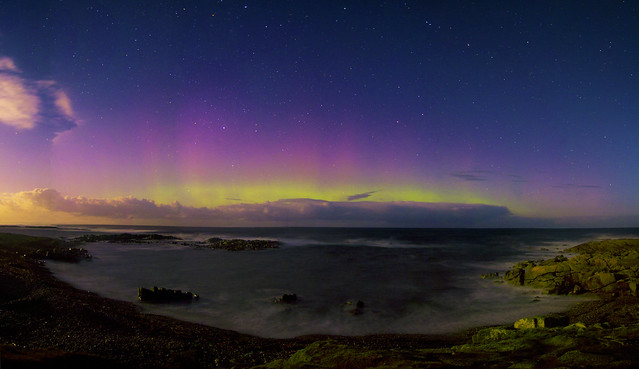
Aurora in the Moonlight by Donegal Skies, on Flickr
Date & Time: 24 Nov 2012, 02:45
Location: North Donegal Coast, Ireland.
Equipment: Canon 1000D, 20mm Sigam F1.8 lens.
Exposure: Four Panel mosaic, 8sec, F2.2, ISO 800.
It was a lovely night, sitting on the shores of the Atlantic Oceans under Moonlight, listening to the waves crashing on the rock and watching the mysterious Northern lights dance across the skies the above.

Aurora in the Moonlight by Donegal Skies, on Flickr
Date & Time: 24 Nov 2012, 02:45
Location: North Donegal Coast, Ireland.
Equipment: Canon 1000D, 20mm Sigam F1.8 lens.
Exposure: Four Panel mosaic, 8sec, F2.2, ISO 800.




